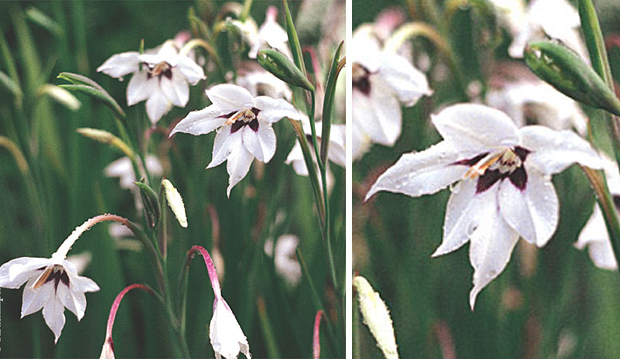Life would be easier if taxonomists didn’t rename bulbs and plants so often. I’ve always had a sneaking suspicion that they own the label companies, making buckets of money every time they change the name on a gardener’s favourite. This may be the case for this month’s bulb that used to be known as Acidanthera.
The recently dubbed Gladiolus callianthus also has the common name of Abyssinian Sword Lily, which is silly because it’s not from Abyssinia nor is it a lily. For awhile, just to confuse things further, this bulb was called Gladiolus murielae. It is little wonder that not enough people grow Gladiolus callianthus when its name changes all the time.
Yes that’s right. Not enough of you are growing these marvelous bulbs, and that’s a shame. Like their Gladiolus cousins, they grow from a corm, producing pretty, sword-like foliage 60 to 90 centimetres (two to three feet) long, followed by wonderfully fragrant, purple-throated, orchid-like flowers in late summer. All they want is a well-drained soil and full sun. They’re small enough to work in containers and cheap enough to treat as annuals. The bulbs will produce numerous offsets, which you can store indoors, but they’ll need several seasons to reach flowering size. It’s hardly worth the effort and the wait, when you can buy 10 bulbs for the price of a coffee and a doughnut.
Plant them in the spring when the risk of frost is past. Containers look best when they’re full so plant them closely if you’re potting them. Otherwise a spacing of two to three inches is plenty.
Pests are few but there is one little critter that is fond of all Gladiolus—the Gladiolus Thrip. They’re really too small to see so it’s best to use prevention by spraying the foliage with an insecticidal soap when the foliage is about 15 centimetres (six inches) tall and again, two weeks later.
Buy the biggest bulbs you can find. Unfortunately, some unscrupulous vendors may offer smaller bulbs that may not be flowering size or, if they do flower, put out a poor show. Like most things in gardening, you get what you pay for.
So give yourself a treat this summer. You don’t even need a garden to enjoy these African wildflowers, a sunny balcony or deck will do.




